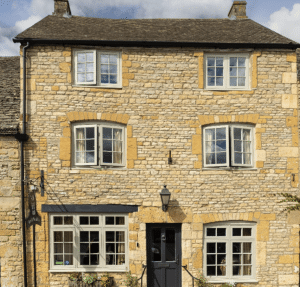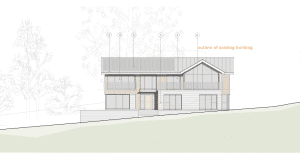Joe has an extensive background in the planning industry with ten years of local authority development management experience before joining McLoughlin Planning in 2019. He has worked on a wide variety of developments, including small, medium and large-scale residential, commercial, leisure, retail, equestrian and agricultural. Joe also undertakes work as a Planning Inspector on a contract basis, which provides McLoughlin Planning with a unique insight into the planning appeal process.
He has a particular interest in development management; listed buildings/historic environment; Green Belt sites.
Joe has successfully secured the following developments on behalf of his clients:
In his spare time Joe enjoys playing golf, spending time with family, European city breaks and watching live sport (either in the stadium or in the pub!)

We are delighted to confirm that McLoughlin Planning was instrumental in obtaining planning permission for the change of use of a Bed & Breakfast (Use Class C1) into a new dwelling (Use Class C3).
The proposed change of use raised a number of key planning considerations which had to be carefully navigated, as the 18th century property is situated in a Conservation Area and within the Cotswold National Landscape.
But the main planning issue was related to the Principle of Development, given the property’s location in Stow’s defined town centre. This area is zoned for commercial uses, meaning new residential development is not usually supported. Despite this constraint, McLoughlin Planning was able to persuade Cotswold District Council that in this case, a residential use in the town centre was appropriate.
Our pragmatic approach, nuanced analysis of policy and site context, and the presentation of a strong fall-back position secured the planning approval for this change of use and the further evolution of this historic building, which will now become a family home.
Councils tend to have policies prohibiting new dwellings in town centre locations, mainly to ensure the ‘vitality and viability’ of the High Street is maintained. However, applications like this demonstrate it is possible to obtain permission for a dwelling in commercial centres. As our High Streets evolve, there is increasing recognition that the introduction of modest amounts of residential uses within town centres can contribute to, rather than diminish, the activity in town centres.
Do you own or are you interested in purchasing commercial property in a town centre with a view to changing its use to residential? If so, then please contact us through either our “Arrange a Call” tab on our contact page or via the email and telephone number provided below.
Joe Seymour – Associate Director
E: joe.seymour@mplanning.co.uk
T: 01242895008
Image source: Knight Frank Estate Agency

It was an absolute pleasure to be part of this proposal in Brockworth for a three-storey, 66-bed care home facility, along with associated ancillary works. Planning was approved in February of this year.
The site comprised a single dwelling in ample grounds, surrounded by playing fields and residential gardens with established border treatments.
Key planning considerations included:
Although outside the settlement boundary for Brockworth, the development site benefitted from being adjacent to a strategic allocation, outlined in the Gloucester, Cheltenham and Tewkesbury Joint Core Strategy 2011-2031. Furthermore, at the time of submission, the Council could not demonstrate a five-year housing land supply. The proposal would therefore help to address the identified need for registered care beds in the locality, and the quantum proposed would make a useful addition to the Council’s housing supply figures.
Regarding the increase in built form compared to the existing, whilst this undoubtedly represented a key planning issue, it was successfully evidenced that the scheme could be delivered without unacceptable wider landscape and visual impacts, particularly given the significant additional residential development taking place adjacent to the site. As a result, we successfully justified that the minor visual harm created by the new built form would be comprehensively outweighed by the substantial benefits that would result from the development.
Given this, a positive pre-application response was received, which acknowledged that the principle of development was acceptable, along with the proposed quantum of development which initially sought an 82-bed care home with associated amenity space, parking provision and a revised access point.
On this basis, working effectively across a multi-disciplinary project team, a full planning application was submitted. However, statutory consultee responses received during the determination period raised several concerns. We liaised effectively with the case officer and wider project team, presenting a series of solutions and mitigation measures to assuage concerns and present a scheme which responded positively to statutory responses and ensured a suitable quantum of care provision, adhering to the vision of our client.
These included:
The application was decided at Planning Committee, and we are delighted that following our involvement, all concerns raised by the statutory consultees were successfully resolved and that planning was approved in a timely manner.
We are McLoughlin Planning, and our team has a simple objective: to get results for our clients by providing high quality planning consultancy.
Our team of chartered town planning consultants deal with a host of interesting planning projects from across southern England and Wales – from strategic promotions and commercial premises to private developments and rural projects.
We are a friendly and approachable team who care passionately about the built environment, always striving to get the best outcome for our clients and the community.
If you have a development project which would benefit from expert planning consultancy input, then feel free to contact us through either our “Arrange a Call” tab on our contact page or via the email and telephone number provided below.
Joe Seymour – Associate Director
E: joe.seymour@mplanning.co.uk
T: 01242 895 121
Project team:
Image source: LNT Construction

McLoughlin Planning has successfully obtained planning permission to demolish an existing dwelling and construct a larger replacement dwelling in the Tewkesbury Borough. The site’s location within the Cotswolds National Landscape (formerly the Cotswolds Area of Outstanding Natural Beauty) and particularly the Gloucester-Cheltenham Green Belt presented significant challenges to achieving the client brief. In partnership with Coombes:Everitt Architects and Willder Ecology –we secured the demolition of a dilapidated dwelling dating from the 1920s, and the construction of a larger contemporary replacement dwelling.
Defining the term ‘materially larger’ in the Green Belt? A holistic comparison can be key
Councils often provide inconsistent guidance or, more challenging still, no guidance at all in terms of the size of a replacement building one is allowed to construct in the Green Belt. The key planning policy test for this application was that the new dwelling could not be “materially larger” than the existing dwelling, which inevitably raised the question: what is meant by this subjective term?
McLoughlin Planning successfully negotiated with the case officer to agree that the proposed dwelling was not materially larger, thus allowing planning permission to be granted. One of the key lessons learnt from this project is that it is not simply a question of comparing the existing and proposed floor areas. The Council will also take into consideration the differences in height, footprint, and volume, in addition to floor area, when deciding whether a replacement building is “materially larger”. Providing a holistic comparison can be the difference between approval and refusal.
I own a property in the Green Belt – how can I obtain planning permission for my project?
We are absolutely delighted with the positive outcome on this project, which will turn an almost unusable dwelling into a well-designed home. The team at McLoughlin Planning are very experienced in the nuances surrounding these types of development projects and navigating the complexities of challenging land designations. If you have a project that might benefit from our expertise, then get in contact with one of our planning consultants to find out how we can best assist you.
Joe Seymour – Associate Director
E: joe.seymour@mplanning.co.uk
T: 01242895008
Image source: Coombes: Everitt Architects (2024)
Project Team:
McLoughlin Planning (Planning consultants)
Coombes:Everitt architects (Architects)
Willder Ecology (Ecologist)
If you are interested in finding out how we can help you please get in touch